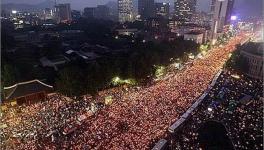Liberal-Progressive Alliance Wins by a Landslide in South Korean Parliamentary Polls

Democratic Party leader Lee Nak-yon, who led the ruling coalition’s electoral campaign, holds a bouquet with his wife after defeating opposition party leader Hwang Kyo-ahn from Seoul’s Jongno district. (Photo: Yonhap)
In what is being seen as a nod to the government’s handling of the novel coronavirus outbreak, the ruling coalition in South Korea secured a thumping victory in the parliamentary elections held on Wednesday April 15. Following the declaration of the results on Thursday, the liberal-progressive coalition of the Democratic Party and the Together Citizens’ Party backing incumbent president Moon Jae-in came back with the biggest majority in the national assembly since the country’s transition to liberal democracy in 1987.
The election turnout saw a major spike of 8.2%, despite the COVID-19 emergency which has infected more than 10,000 people in South Korea. This was also the first election to be held under the recent electoral reforms passed by President Moon that split the 47 proportional seats in the assembly into two categories.
In the earlier system, members to 47 seats were elected through parallel voting with a separate electoral list. The current system has reduced this number to 17 and turned the rest of the 30 seats into compensatory seats to even out the differences in vote share to seat share in the directly elected constituencies.
The ruling coalition won 180 of the total 300 seats in the national assembly, an increase of 35 seats since the previous elections in 2016. Moon’s Democratic Party won 163 seats, while its coalition partner Together Citizens’ Party won 17. The coalition also saw an increase in its popular vote share to around 33.4% of the party-list votes, up by almost 8% from the 25.5% votes in 2016.
On the other hand, the right-wing and conservative United Future Party won only 84 seats. Its coalition partner Future Korea Party won 19. The United Future Party, although new, is the successor of the traditional Saenuri Party or the Liberal Korea Party that was led by impeached president Park Geun-hye – daughter of former military dictator Park Chung-hee.
The 2016 political scandal that surrounded Park Guen-hye prompted a split in Saenuri, with most of its members defecting and later forming a series of different parties, eventually settling into a right-wing big tent, the United Future Party. The right-wing coalition held a plurality of seats and votes, and dominated the national assembly until the election of Moon Jae-in as president in May 2017.
Moon was elected on a platform of intra-Korean peace, anti-austerity and anti-corporate corruption that had marked the Park administration. The leader of the United Future Party, Hwang Kyo-ahn, who served as the prime minister under Park Geun-hye, lost his seat to Democratic Party’s Lee Nak-yon who served as prime minister until January this year and led the party’s campaign. The leftover rump party of the former Saenuri won only 0.3% of the votes and no seats.
The results are being read as a positive verdict on the government’s actions during the COVID-19 outbreak. South Korea is one of the few countries to stand out with low death rates, despite a large elderly population. The death rate stands at around 2%. It is also one of the few nations to have a testing rate of more than 10,000 to every one million in the population, allowing early detection and containment of much of the infections.
Get the latest reports & analysis with people's perspective on Protests, movements & deep analytical videos, discussions of the current affairs in your Telegram app. Subscribe to NewsClick's Telegram channel & get Real-Time updates on stories, as they get published on our website.

















